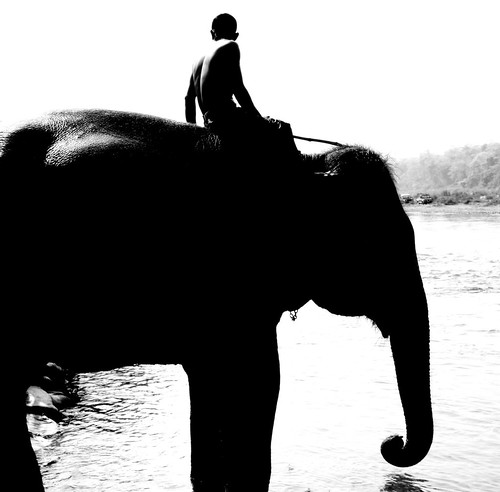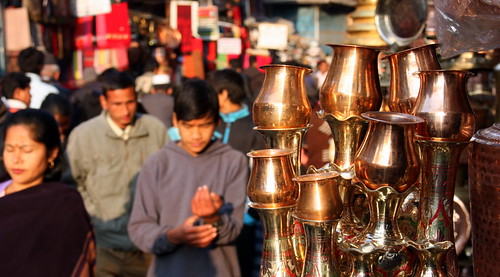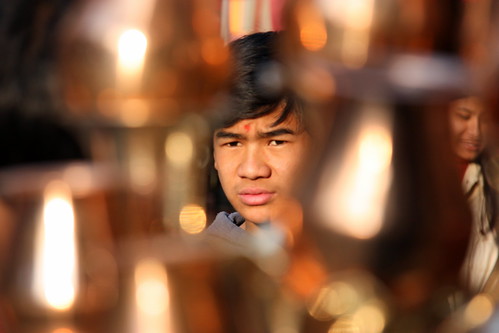Thursday, November 05, 2009
Not everything in Darfur makes perfect sense. I just completed a paralyzingly dull day of workshops on the environment and natural resources in Darfur - most of which was in Arabic and thus of predictably little value to me. One of the few portions sufficiently translated was an exploration of how an explosion in the number of nomadic herders (and consequently in their flocks) has ravaged the environment of Darfur. The numerous and hungry sheep, goats, cattle and camels devour grass, shrubs, trees, roots, and whatever other edibles they can find in an already shockingly inhospitable environment. This further dries the environment, erodes the soil, kills most of the plants lucky enough to escape the goat's teeth. More immediately, it also drives the growing number of herders onto land occupied by a similarly soaring population of farmers, where their critters, being critters, find lovely and well-nurtured crops upon which to feast. The herders are desperate, the farmers aghast, and one or both of these parties usually has an AK-47. Throw in a hefty dose of Machiavellian meddling from the central government and a ton of complexity I haven't hinted at here, and voila - you get the Darfur conflict. So it's clearly an idea beyond reproach that, among a great many other things, weaning a few well-armed nomads off their herding lifestyle might pay some delightful dividends in reduced environmental damage and bloodshed.
The next presentation was a discussion of how to improve the lot of nomadic herders by making it easier for them to increase the size of their herds.
This is one of the lesser of many insane contradictions espoused by well-meaning people today. What an odd place.
Tuesday, November 03, 2009
I suppose I could say my plate is full. I'm bouncing back and forth between Khartoum and various metropoles of Darfur and, on one happy but too brief occasion, Switzerland. I'm working absurd hours, though to be fair I just partook of my first proper weekend in a month or so. I'm learning a ridiculous amount about subjects I hadn't known existed. All this is in service of a $2.5 million project that operates (lightly and loosely) over an area roughly the size of France. Oy. But jeepers, it's interesting stuff - at the nexus between war and poverty and the environment, using technology waaay beyond my understanding to tackle (or at least comprehend) problems similarly beyond my pay grade.
If only I didn't have to relearn Spanish in the next 3 days. Speaking of which, I'm strongly considering abandoning my bid for the Canadian Foreign Service, propelled largely by their hideous lack of communication over hte last year, their nightmarishly disorganized HR department, and my growing impression that I'd spend most of my career trapped in Ottawa, sequestered away from the (rather captivating) sort of field work I'm doing now. Choices, choices...
Tuesday, October 13, 2009
Tonight after leaving work, the last by an hour or more, I settled into a wire chair at the Lebanese restaurant with which I've grown too familiar over the last months. After eating I ignored the bill on my table for an hour while devouring the final heartbreaking pages of What is the What, which I've been criminally tardy in completing. I'd recommend it immensely even if I weren't here. I recommend it all the more for the fact that I am.
I've been gone awhile from the interweb, and a few inquisitive folk have written requesting tales of adventure. I've written little because I have little to tell. There's a mundanity to my daily life you wouldn't expect from the exotic sound of Khartoum. My office is a block from my home, and between the vicious hours I log at the former and the few I while away at the latter, I pass many a day without leaving sight of either. But it's time for me to invest a little more effort in finding (and sharing) the bits of wondrous texture I'd encounter if I weren't working so damn hard, like the melody of the evening call to prayer that rings from the mosque just out my front door.
More wonder should be easier to find now that I'm dragging myself out from behind my desk. My project, a potentially fascinating mix of environmental science and conflict management, is beginning to rise steaming from a murky ocean of paperwork and take ungainly flight. I'm off to Switzerland on Wednesday to consult with a long-courted subcontractor, and back for a blink on the weekend before I depart for South Darfur for two weeks. There will be more to tell - always is, I suppose, if I make the time to tell it.
Thursday, August 13, 2009
A pygmy hedgehog just wandered into my living room, snuffled around a moment, and vanished behind the couch. Not what I expected from a legendarily shy creature.
But a decent welcome to Darfur - or technically El-Fasher, the capital of North Darfur state. What little I've seen of massive Darfur is precisely as flat and dry as you'd expect from the newspapers, with drifts of dust a foot deep against walls. But it is the rainy season, and as we drove in on Monday from the airstrip, goats huddled single-file against walls, seeking scant shelter against a few minutes of unexpected rain, and donkeys clustered, shivering in the low-30s heat, under the few dessicated trees. El-Fasher is a single-story town, nearly as flat and featureless as the desert surrounding it. I've seen very little of it, because Sudan is a country roughly the size of Western Canada, and Darfur the size of BC, and there are few incentives to conserve space when building towns. It's spread out to an almost comical degree, with roads (a term charitably applied) often a hundred meters. The sky is imposingly vast, and after a brief and intense shower yesterday morning, cloudless and startlingly blue.
There goes the hedgehog against, poking unhurriedly around the lawn furniture of my guesthouse.
I'm here in Sudan for a few months to help an NGO coordinate support to people displaced by the Darfur crisis, and I'm unlikely to often offer more detail than that. I'll spend most of my time in Khartoum, the similar dispersed capital that's nonetheless rather more welcoming than Kathmandu, at least according to my single day's impression. I'm here in El-Fasher, many hundreds of kilometres away, until Saturday, learning the ropes and shaking the hands of the people I'll be collaborating with in the coming months.
I've got much more to tell, but first I think it's time to see if that hedgehog wants to be my friend.
Sunday, August 09, 2009
For example:
During a brief but lovely visit, Emily and I took a too-short sojourn to Pokhara, the anti-Kathmandu - a serene, yet still marvelously entertaining city where, had I been sane, I would have settled rather than in the nightmarish capital.
The rainy season turned Kathmandu to goo. (Hey, that rhymes!)
My thuggish, sleazy bottom-floor neighbours nicked $500 from my coffee table. I'm loth to go into the details, but suffice it to say that it wasn't due to any silly lapse in security on my part but rather to a previously unexpected layer of depravity on their part. Jenn and Court (my cool and considerably less larcenous neighbours) have informed me that the theft has led to the eviction of the guilty parties, so I'll call that a Paul victory, if a Pyrrhic one.
And I'm in Sudan.
Bedtime.
Sunday, June 21, 2009
Like many, I'm completely enraptured by what's underway in Iran. An uprising long in the coming and provoked by a ludicrously blatant fraud is well underway. I've learned repeatedly (and always the hard way) that dictatorial regimes are as a rule far more tenacious than one would expect, and tend to hold on long past their appointed bedtimes. However, I see some reasons to hope there's permanent change underway in Iran.
When the monks of Burma rose up against the State Peace and Development Council in 2007, there was never much hope for them, despite the romantic glory of the images and the undeniable rightness of their cause. The Burmese military never showed any signs of internal fracture, or of any refusal to obey the regime's brutal orders. And without any change inside the military, any collapse in internal discipline, no change was ever really in the offing. The situation in Iran feels different. I don't believe that the Iranian police will have the unwavering, uniform mercilessness required to crush a worthwhile uprising through force alone (though the basijis are another matter. I don't really believe that they'll systematically slaughter thousands, in the manner of Tiananmen, as opposed to the sporadic brutality seen in response to protests in the last couple of days. And if that's true, as I desperately wish, then I don't think they'll be able to suppress this uprising; military discipline could fail, and we might see soldiers and policemen siding with the protesters.
Damn, I hope so.
Thursday, June 18, 2009
I had planned a great meandering post on this, the occasion of my 30th birthday, but I got far too caught up in having fun and wandering around Thailand. Narcissistic details on my decade marker will surely follow, but I think it's time to go track down more food!
I love Thailand.
And I'm fairly certain that my 30s will treat me as well as my 20s did.
The best times are yet to come.
Tuesday, June 09, 2009
When I described Kathmandu as one of the worst cities in the world, I feared I might have been exaggerating. I apparently wasn't!
To my endless joy, I'll be spending the next two weeks marinating in the sunlight and pad thai of Bangkok - precisely the break from Kathmandu I need! That's assuming I survive the next two days of grueling work securing funding for my NGO. I'll have a very quiet online presence for the coming days, but hopefully there will be lovely pictures of Thailand to soothe the soul.
Tuesday, June 02, 2009
I've been off the grid for some days now. It's not because nothing's been going on - quite the opposite. I've had a proposal shortlisted and now have a 40-page application to write, to secure oodles of funding for my organization. That's claimed most of my waking hours of late, inevitably. In fact, it's about to take me out to the mountains for a few days, where my colleagues and I will hole ourselves up for 3 or 4 days to write a first draft. I'll be incommunicado until then. But I did want to pop online for a moment and wish Emily (who I'll be seeing in 9 days - yay!) a happy Healthy Brain Day! Here's to many more!
Monday, May 18, 2009
The Liberation Tigers of Tamil Eelam have earned their extinction, and today it apparently arrived as Sri Lanka declares victory after a half-century of hideous civil war. The Tamil Tigers are one of the most reprehensible guerrilla groups on Earth. They pioneered modern suicide bombing, refining a technique later imported to the Mideast by Hizbullah with such hideous consequence. They have proudly assassinated hundreds and massacred thousands. They have inducted child soldiers by the thousands and committed acts of grave ethnic cleansing against ethnic Sinhalese living in the territory that the LTTE claims as intrinsically Tamil. They have used the very Tamil people whom they claim to represent and defend as human shields, even into the last hours of this terrible war. The Tamil Tigers deserve to vanish.
But.
In pressing towards a deserved victory over the Tigers, I fear that the Sri Lankan military and President Rajapaksa have accepted its own rhetoric about the finality of military triumph. The LTTE earned their end, but many of the grievances that animated them are inconveniently legitimate and will outlive them. Ethnic Tamils face religious and cultural discrimination, a painful shortage of economic opportunities and, particularly in the wake of the war, a gruesome humanitarian crisis. If the Sinhalese majority fails to address these issues, then Sri Lanka's crises will continue. The Tamil Tigers (or whoever claims their name) will wage a quiet war of bombings and assassinations much as they did in the 1980s, with the support of enough Tamils to sustain their efforts indefinitely, and Sri Lanka will not have peace.
I'm not optimistic. The Sri Lankan military was no more restrained in the latest round of fighting than the Tigers themselves; both sides have almost certainly committed war crimes in recent weeks. The government has shown, in its moment of triumph, painfully few signs of a serious effort at national reconciliation. The end of the Tamil Tigers presents a rare opportunity, a necessary but not sufficient condition for lasting peace. It must be paired with genuine and effective programs to extend opportunity and cultural protections to ethnic Tamils, or peace in Sri Lanka will be short-lived indeed.
Sunday, May 17, 2009
Blogger's misbehaving badly... or possibly my computer is. There was a massive series of Maoist rallies today, of which I have photos that I'm desperately trying to post. Meanwhile, the other parties are likely to form a government without the Maoists as early as tomorrow, at which point things could get really nutty. I'm going to try to whip Blogger into shape and post photos... your patience is greatly appreciated.
Thursday, May 14, 2009
You may have gleaned that Kathmandu’s hardly a paradise. Hell, let’s add a little more hyperbole: Kathmandu is surely the most unlivable city I’ve ever seen. From the sidewalk-spanning pools of garbage and the raw sewage stink of the holy Bagmati to the suffocating dust-fog and the absurd, broken Nash Equilibrium of the local traffic, this place is nearly as hideously dysfunctional as developing-world metropolises get. The great tragedy is that this lunacy makes it easy to forget that this, one of the world’s worst cities, is located in one of the world’s most beautiful countries. I’m discovering that it’s painfully essential to leave Kathmandu frequently (once a month, ideally) to avoid gruesome burnout and remind myself of the incredible offerings of Nepal’s vast outdoors.
My two-day rafting trip the weekend before last is a harrowing and entirely worthwhile case in point. Waking at the uncomfortable hour of 5 AM, I trudged from (comparatively) ritzy Baluwater to the narrow, nerve-jangling tourist ghetto of Thamel, to meet my erstwhile raftmates (including a half-dozen Vancouver Islanders!). None were in tip-top shape, the innocent victims of liquid overindulgence two nights before (!) and a far-too-early morning. For my part, I hadn’t had an instant of sleep the prior night, kept conscious first by my appetite for episodes of Deadwood, then by rare insomnia, and then by the glorious news that I’d passed my foreign service exam.
We all dozed fitfully through a blessedly uneventful bus ride, three hours north of Kathmandu to the district of Sindhupalchowk, on the Tibetan border, parking on a gravel plain on the banks of the Bhote Khosi river, and tested the dark, swift, shallow waters while our hosts prepared an inoffensive lunch and briefed us on river safety. The river was as cold as you’d expect of water that quite literally melted yesterday; every abrupt dunk provoked spasms of gasping and the familiar, unhelpful urge to go fetal to preserve body heat. That passed, thankfully, and by the afternoon of the first day many of us were cheerfully hurling ourselves into the water in the rare calm stretches between white-knuckle rapids.
It’s a good thing too, for once we got on the water every one of us spent some involuntary time in it each day. The Bhote Koshi hosts genuine rapids (often Class 4 on the 1-5 scale) that took obvious delight in hurling us from our rafts. Rounded rocks taller than I am dotted the river in most places and many more concealed themselves under small swells of water.
I’m a reasonably experienced rafter, as BC has some mighty rapids, but the Bhote Koshi was definitely an exercise in intensity, with surprisingly few calm and quiet spots. Those few serene places often sported riverbanks half-crowded with happy children waving at us; and more than a few cheerfully swimming alongside our immense rafts. I think it amused them enormously, the sight of foreigners swaddled in protective equipment while the children themselves swam unconcerned through some unsettlingly quick water.
Even those kids had the good sense to stay clear of the meaner rapids, one of which provided us with a moment of collective terror that rivals just about any of my more foolhardy moments. Entering a particularly sharp rapid early on the Saturday afternoon, the second-to-last of six rafts in our tour, our far-too-quiet guide shouted commands that we six rafters failed to hear over the water’s roar. We struck a vast rock, inadvertently wedging ourselves ourselves high onto it, while the water continued to pound at the lower edge of the raft. Hydraulics worked their magic, and the boat abruptly flipped, a moment after we all realized we had no power to prevent it. Rafters and guide, we all pitched into the cold water.
It’s quite a thing, to be utterly at the mercy of the elements – I don’t think I’ve ever been so aware of my own useless inertia. Instantly separated from my compatriots, I found myself flying downriver with absolutely terrifying speed, bobbing, gasping. Instantly my lifejacket seemed a useless thing, a frustrating, waterlogged, purposeless anchor – I was momentarily furious at it for failing to keep my head above water. In retrospect, I suppose that my quarrel was with the fuzzy boundary between water and froth in a river that angry; lifejacket or no, you’ll never float above the foam, and I’m now sure that the lifejacket kept me much closer to the surface, where I could enjoy the occasional furtive breath. South Asian river water is as healthful a beverage as turpentine (it’s clear and looks clean but surely hosts a swarm of novel ailments), but in between involuntary bobs it was impossible not to half-fill my mouth with the stuff as I grabbed at sparse lungfuls of air. Each time I reached the surface, I could only clear my airways by half-sputtering, half-swallowing, and I’ve no doubt I welcomed a healthy dose of giardia (for which I’ve since pre-emptively self-medicated) into my body along with a pint or two of river water. I remembered after a moment to point my feet downriver and lie on my back (the finest advice I’ve ever received), and a great back monolith that then seemed fifty feet tall rushed up to smack my soles. For the most part, the river guided me around the more savage rocks and my bent legs cushioned the unavoidable impacts.
Eventually, I found myself in reach of a rescue kayak, which I assume came to me, since I was probably too concerned with breathing to reach it under my own power. I wrapped my legs around the bow until it reached a nearer raft. I was hauled from the water, substantially bruised and mildly bloodied, but ultimately no worse for the experience. I was not especially coherent at the time, I’m told, but did manage to ascertain that everyone else in our raft had been similarly plucked from the water, and the raft had then righted itself without supervision. Our paddles were snatched and returned by other rafters downstream, and someone even managed, miraculously, to find my missing sandals. My sunglasses, however, are gone forever. We were repatriated to our raft, lectured unduly by our guide, and resumed our journey. Some were more shaken than others; we eventually redistributed the less experienced rafters to other rafts where they felt more comfortable; our harrowing flip was not repeated. At least, not by us – a couple of other boats had similarly life-affirming experiences.
That experienced, however startling, reinforced the terrific importance of getting some occasional contact with nature at its unyielding best. Kathmandu challenges the soul but rarely the body; you can flirt with death in rush-hour traffic (which I typically avoid) but there’s no exhilaration to be found. Out in the Bhote Koshi it was possible to remember, often forgotten in Kathmandu, that there are places where I can exert myself without a particulate filter on my face, where a deep breath is a pleasure rather than poison, and where every small joy needn’t be fought for tooth and nail against the aggravations of the city.
This is still Nepal. Ugly pinwheels of flotsam and thick black bubbles often whirl in the eddies behind riverside rocks, and behind every village and home on the bank a small, stinking landslide of junk flows down to the water’s edge. Very few people here give a second thought to tossing garbage down the nearest hill or into the river behind their homes, and so mounds of torn plastic and wadded paper blight many views that should be pristine. Sewage processing is inadequate in the big cities and simply non-existent everywhere else; even along the lovely Bhote Koshi, the houses perched fifty feet up the cliffside often simply discharge their drains from overhanging pipes directly into the river.
But the Bhote Koshi is beautiful far more often than not, black rocks and deep gorges presenting an illusion of isolation impossible to find in Kathmandu. Many of our crew swore off rafting permanently after we capsized; I was ambivalent, myself, but in the two weeks since I’ve felt a powerful need to get back on the water or do something comparably exhilarating in clean air. Two days out of the city recharged me enough for the past two weeks of hard work; I think I’ll need to make a regular ritual of it. Surviving Kathmandu demands no less.
P.S. Pictures will follow – my camera stayed at home, but Craig and Kristen have a waterproof point-and-shoot that likely captured some candids of me in the throes of mild terror.
Monday, May 11, 2009
That no news is good news. Nothing of real significance has happened over the weekend in Nepal's ongoing, slow-motion constitutional crises. If there were protests today or yesterday, I didn't see them, and it's tempting to think that we've dodged a political bullet here. Unfortunately, this country in desperate need of good government remains politically decapitated, with no Prime Minister, no ruling party, and certainly no one setting a comprehensive plan for ensuring "paani, bijuri, baaTo" (water, electricity and roads) for the 70% or so of population going without. Everyone who has a full stomach is fixated on the inter-party imbroglio; I presume everyone else is mainly preoccupied by coping with crippling fuel shortages and vegetable prices that have risen fivefold in the last month due to intermittent blockades of the trade roads to India.
So, in the absence of new news, I offer photos from last week's goofy yet absurdly well-coordinated street rallies. As I pedalled sweatily to work on Thursday the road, previously painfully thick with traffic, instead became this:

I've gradually learned that this is a bad sign during rush hour in Kathmandu, typically home to some of the worst traffic in South Asia (and by extension, the known universe). So I went wandering, and a block away found a Maoist rally, loud and surly but obviously well-disciplined and not visible hostile to my intrusions with my camera.

Police kept a conspicuously close eye on the whole process, maintaining a light human cordon around the entire moving crowd (which was perhaps five hundred people strong, though I've no real ability to estimate crowd size).

I wandered briefly alongside the crowd and then decided against making my way to work; there's no telling, on a day like that, when the return commute will be possible. En route back to my own neighbourhood, I encountered several dozen motorcycles, each carrying two men (one to drive and the other to wave the Maoist flag and yell). They'd pause every block or two to whip each other into a riotous frenzy and then continue on their way.

I have no idea what this guy said, but he really got the Motorcycle Maoists fired up.

They left rather unimaginative tags on the pavement as they paused - Y.C.L.N. is, you may have surmised, the Young Communists League of Nepak - the Maoists' unnervingly numerous and slavishly loyal youth wing.
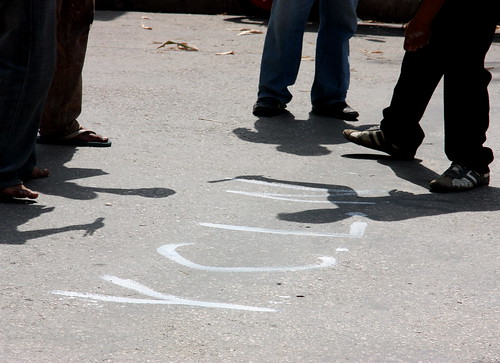
Once the motorcyclists passed, they were succeeded by another crowd of protesters, led by two rows of shirtless YCL drones bearing (I'm told, but could not read) high-minded satire written across their chests. They flanked a wheelchair-bound effigy of the reviled (by the Maoists) Ram Baram Yadav, leader of the opposition Nepali Congress party and a focal point in the vicious debate that precipitated all this lunacy. Of the wheeled impostor, however, I have no worthwhile photos. My apologies.
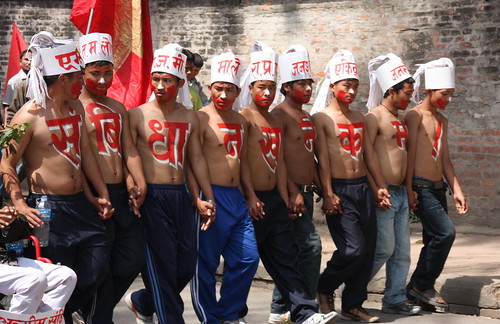
I was invited to join the protest (presumably with my shirt on), but demurred. And that was my Thursday, for I shortly thereafter fled back to the CECI office and my home. That was the last protest I've seen, though I'm told many more have taken place since then. We're still on tenterhooks here, waiting the next ill portent. It's likely to be the apparently imminent announcement of a coalition government between the (ideologically opposed) United Marxist-Leninists and the Nepali Congress, which will probably exclude the Maoists from seriously power and provoke another round of anarchy. I'm not putting any money on it, though - prediction is a fool's game here.
I'm sequestered at the CECI office right now in northern Kathmandu, across town from Worldview (my more permanent employer), where I fled after the lights went out and my laptop battery died. I crossed town accidentally (and miraculously) just before the storm of the century tore loose and turned the roads into opaque rivers. If you've never heard a serious hailstorm on a tin roof before, you'll need to seek it out. This is what the apocalypse will sound like. I'm hiding from the torrent of hail and the literally endless rumblings of nearby thunders, watching my bicycle submerge in the yard outside the window, and trying to figure out how to make the 5-minute ride home without drowning.
Friday, May 08, 2009
There's been an uneasy but relatively undisturbed calm on Kathmandu's streets the last two days, as the populace waits (with either trepidation or eagerness) to see how the Maoists will respond to the near-certainty that they will be shut out of the next government. One party covenant after another is underway, the Maoists have consistently disrupted Parliament from within and without, and minor protests continue to echo around the city center. But the schools are mostly reopened, the traffic only periodically paralyzed, and the reports of protest-related injuries mercifully few. Nobody really expects it to last, but one thing I've learned over the last six months in Nepal (with a real crash course in the last week) is that anyone who predicts the political future here with any certitude is a blooming fool. No one really knows what's going to happen, and we may not for months. It's almost certain, though, that something will have changed by next week; those meetings have to draw up some actual resolutions at some point, even in Nepal, and the party faithful won't wait forever for their marching orders.
Technical issues crippled my attempted uploads of rally photos yesterday - hopefully my cable modem will have ended its own protest by this afternoon and you'll have visual evidence of the oddities of the Young Communists of Nepal shortly thereafter.
Wednesday, May 06, 2009
Then I'd know better how to make sense of the last day's events. Perhaps... or perhaps everyone around me, Nepali-speaking or not, is equally befuddled.
The Maoists are struggling to reclaim the moral high ground, if ever they had it, after the suspiciously well-timed release yesterday of a year-old video showing former Prime Minister "Prachanda" bragging to an inner circle of party elders. He boasted therein of having deceived the UN and the country regarding the strength of Maoist forces at the end of the war - the official tally was 25,000 troops, far in excess of the apparent true figure of 8,000. This has arcane implications for the peace process, none of which I'll dive into here. What I will explore was a pieace of Prachanda's response, though I wonder if it's gained something in the translation - an element of menace, if you will.
Speaking at a press conference to respond to the furor over this video, Prachanda (I really shouldn't call him by his own self-aggrandizing nickname, but it's so much easier than "Pushpa Kamal Dahal") grew visibly agitated. Pressed about the tape, he eventually burst out that h was considering releasing more tapes, from during the conflict, showing the brutal murder of various people by his own party. Saying, "I am thinking of giving you another videotape to disclose the rebellious character of Prachanda," he elaborated that the tapes would give the public a more complete understanding of the true ideology of the Maoists.
This was all said in Nepali, of course, and translation is a notoriously unreliable creature here in Nepal. But is there any way to interpret this other than as a gruesome threat? At the very least, it was a terribly intemperate outburst at a time that demands calm, and it supports my continuing view that Prachanda lacks the will, wisdom or temperant to tamp down his furious hordes and reduce the risk of renewed war.
There was a rally tonight in Baneshwor, the core government district of Kathmandu today, wherein Maoist activists brandished torches (in an allegedly non-threatening way) in front of the Parliament. Sadly, despite my best efforts, I couldn't find the bloody thing, which would surely have produced some fine photographs. As it was, I wandered confusedly around downtown Kathmandu for an hour before admitting defeat and heading home. On the walk back to my apartment, I unwisely crossed under the trees ringing the grounds of the now-disused royal palace. These trees are the nighttime nests of apparently all of Kathmandu's birds, and my choice of route had predictably messy results. To compensate, I did find myself in the midst of a gloriously intense swarm of fireflies closer to home; for a born-and-raised Vancouverite, fireflies are a novel treat.
Working at home becomes rather less productive when there's no juice in the lines, so I attempted journey this morning across town to my office, despite foreknowledge of certain civil unrest. This voyage is harrowing and uncertain at the best of times, Kathmandu traffic being what it is, and takes a hair over half an hour. It becomes noticeably more so when roving protest gangs, ranging in size from a few dozen to a thousand or more, cheerfully obstruct traffic and quite consciously bring the maximum disruption possible to an already disrupted and inconvenient city. Today it took me an hour to give up my foolish ambition to... well, to actually get a proper day's work done, something that hasn't happened for anyone in Kathmandu since the start of this crisis. In that hour, I covered half the distance to the office, and was ultimately defeated by hordes of red-flag-waving militants and their advance guard mounted on several dozen motorbikes, all members of the Young Communist League of Nepal, the youth wing of the Maoist party. I was startled by their strict organization and near-military discipline, apparently a hallmark of the Maoists. Thankfully, none of the other parties' own youth militias appeared, and extensive conflict was forestalled.
They even (I think) invited me into the rally as I (non-belligerently, I hope) took photos from the sidelines. I think, however, that such participation violates both my contract and my ideological leanings, so I pretended the tourist and stood slack-jawed while they pass instead. I'm hearing now that the tear gas has been brought to bear by the police, and that a handful of Young Communists have been hospitalized. I'm comfortably ensconced in the CECI office down the street from my home, well away from the violent proceedings. I do, however, have a handful of photos from this morning's demonstrations, and I'll post them when I get home.
In the meantime, I'm aggravatedly contemplating the fact that it took me an hour to throw up my hands in defeat during my morning commute, and another hour to return to my own neck of the woods. Two hours to travel nowhere.
Kathmandu is a hard town if ever there was one.
With the Prime Minister's ouster, my electricity supply has abruptly dropped, from nearly 24 hours daily to something like 4(?!). I attribute this unfortunate happening to the fact that my house is close to his official residence, and thus enjoyed a somewhat privileged status these last two weeks; with his abdication, I think we're being punished. It hasn't made blogging easy.
Fortunately, there hasn't been all that much to blog about in the last day. Things in Kathmandu stayed surprisingly quiet. A late-afternoon bicycle sojourn revealed tire soot on the main streets but few other symptoms of unrest. Perhaps 50% of the stores were open, an unusually high portion given the situation. Street violence in the (to me) remote district of Rolpa killed one person, but I don't think there was any such activity in the capital.
So I'm going to work today - kindly cross your digits that I don't get trapped on the other side of Kathmandu.
Tuesday, May 05, 2009
So far today, it appears so. The streets are presently what passes for quiet in Nepal (a mildly deafening din of furiously keening street dogs, rough-hewn construction work without power tools, and noticeably fewer honking car horns.) It's a hair after noon and the protests are currently under wraps, as the parties have all convened to plot their next steps. Major protests are still expected this afternoon or tomorrow, but for the moment things are calm.
It's probably still best that I didn't go into work today. My route to the office and back takes me not only clear across this chaotic hive of a city, but directly through a warren of politically tempestuous colleges home to the local youth wings of the key political parties. When things go wrong in Kathmandu, that's invariably where the misery starts. I have no desire to find myself trapped at the office at the end of the (short, marginally productive) workday.
Monday, May 04, 2009
I can dimly see the lights outside the former Prime Minister's official government residence - a house and parcel of land remarkably modest by head-of-state standards. I see no disturbance there; I don't even know if he still lives there - does a Prime Minister abruptly pack his bags and move upon resigning? Methinks the rules for this sort of thing aren't especially well codified. In any event, the sickly yellow streetlamps that ring his home are lit and betray no signs of agitation or violence; but then, I'm rather far away. Inasmuch as my last house in Kathmandu was across the street from his place, bathed in that wan, mildly nauseous glow, I'm rather glad for the greater distance. Prime Minister's Lane seems an imperfect place to live right now.
Word is that the Maoists will be launching street protests as wide as they can manage (and their reach is wide indeed) to augment their imminent uprising in the Parliament itself. This will be complex, and it will be very interesting to see how the army responds. I'm still not making any real predictions; tomorrow will hopefully be informative and minimally violent.
CNN India is reporting that the Nepali Foreign (Finance?) Minister, a Maoist, is claiming that the resignation of Prachanda (the Maoist Prime Minister) enables the party to retake the moral high ground. They are arguing, as I expected, that the Maoists were not undone by their own overreaching but rather betrayed from within by agents of India acting through their erstwhile coalition partners. Allegations of betrayal are one of the surest ways of firing up any party's restive hardline base. He has, apparently, stated that it's time to "take the fight to the city" - surely meaning Kathmandu, which was largely untouched by the civil war. I have no way to assess the credibility of these threats, but I was planning on staying at home tonight anyways.
Meanwhile, the Prime Minister's resignation speech included such tidbits as blaming "foreign powers" for his government's lack of progress. "Foreign powers" is always (always) code for India here. I don't have much reason to believe him - this has always felt like a homegrown crisis to me. That said, there's a great deal I don't know - for such a small country, Nepal has fantastically complex politics which I am as yet struggling to understand.
For the record, I have no idea what procedures this resignation will trigger under Nepali law. Nepal is still writing its true Constitution, and the Interim Constitution is a raggedly ad hoc and incomplete document which (I believe) offers only minimal guidance in a complex and evolving situation such as this. I'm certainly not expecting to be going to work tomorrow, it seems, so I'll be updating throughout the day if the power stays on.
For those following along at home, CNN-IBN is a good source for quick updates, while Nepal News is tolerably fast and a lot more local.
...except rumours.
There are unsettling moments when, perched on my bike, I realize that the road around me has become suddenly empty, the bustle evaporated and the throngs of glossy, underpowered motorcycles abruptly nonexistent. I usually realize then that everyone else knows something I don't, and that it's time for me to get off the roads, preferably home and certainly out of the way until whatever calamity passes.
All Kathmandu feels much like that this week, and it's likely to get worse. I returned last night from a whitewater rafting adventure (which left me bruised and sore and much entertained) to discover that Nepal has entered a long-incubating political and constitutional crisis from which it's very unlikely to emerge without fresh scars. The government has fallen in all but name, and will most likely officially die tomorrow afternoon. The fallen and their opponents are all mobilizing their professional thugs to contest whatever outcome on the streets. Violence is very much in the air, and I'm more than mildly nervous.
It's worth noting early on that, reportage being the unreliable beast that it is in Nepal, and rumours so often fantastically elaborate and ill-founded, my understanding of the facts on the ground is incomplete in many places and no doubt downright wrong in many others. Here's a little background, streamlined and simplified, as best I understand it:
The Maoists, officially the Communist Party of Nepal (Maoist) or CPN-M, are the largest of several extreme-left parties that emerged the principal victors of Nepal's 2008 elections. Those elections were one of the steps that ended the decade-long Nepalese civil war, behind which the Maoists (but by no means only them) were a principal driving force. The Maoists formed a government in coalition with several of their ideological near-brethren such as the United Marxist-Leninists (Nepal being one of the adorably few remaining countries where the myriad flavours of Marxism are goofily thought to be practically different). Ideological opponents such as the Nepali Congress Party, which ruled Nepal none too successfully for many years, made up the large bundle of minority representation in Nepal's fragile and fledgling Parliament.
Unfortunately for the Maoists, they've had a rather unpleasant but utterly inevitable lesson, which they might have vitally learned in advance if they hadn't been blinded by discredited ideology: toppling a government and running one require radically different skill sets. Enormous rifts, which I will mostly ignore for now, opened between the ruling coalition partners, and between the government and the opposition. The most germane was regarding the Nepali Army, a well-trained, highly-disciplined and very proud force which was asked to integrate the irregular combatants of the Maoist People's Liberation Army (PLA), the fanatically dedicated but rather more ragtag guerrilla force with which the Maoist's waged their ten-year insurgency. The Nepal Army, as conservative as any you'll find (and armies are a conservative lot) chafed at the thought of inducting the tattered PLA, let alone giving them command posts. Chief among the objectors was the Army Chief of Staff, General Rookmangud Katawal, the country's top military official and one of the few people with the means to topple the government.
The Maoists, led by Prime Minister Pushpa Kamal Dahal, lead instigator of the war, demanded the sacking of General Katawal, who unsurprisingly refused to step down, leading to a month or so of speculation that Katawal would simply remove the Maoists from power himself, with the loyal Army behind him. The Maoists' coalition partners, fearful of this very event, urged the PM to abandon his plan, instead allowing Katawal to serve out the remaining five months until his planned retirement. No dice. The Prime Minister unilaterally declared that the General was officially out of a job, though the authority over the Army lies with the President (who is not a Maoist and rejected the move).
Here's where things take a turn for the byzantine and the purpose of my long-winded exposition becomes clear. The Maoists have no constitutional authority to take any action without the support of their coalition partners - they simply haven't the votes, which is precisely why coalitions are formed in the first place. But, visibly indignant that anyone would doubt their supremacy, they "fired" Katawal anyways, attempting to rule by decree rather than democracy. Several things happened:
- The President, of the opposition Nepali Congress party, told Katawal to defy the Maoists.
- Katawal, a proud man, ignored the Maoist edict.
- Most provocative, the Maoist's coalition partners, incensed that the CPN-M would attempt to rule by decree and override their position, abandoned the coalition, leaving the Maoists without the votes to form a government.
In most Western countries in this state, we'd see a flurry of furious politicking and horse-trading as all concerned scramble to form a new government. But this is Nepal, and the Prime Minister has previously said that if the Maoists ever lose power by legal means, they'll simply pick up their guns again and reclaim it the way they prefer. It's a credible threat; ever since the war ended, many of the Maoist's grunts have been visibly itching to get back to guerrilla combat. They've discovered, as I've previously mentioned, that tearing around the country blowing up government offices, robbing villagers and taking potshots at soldiers is a great deal more fun and sexy than the drudgery of actually writing and implementing policy. Many are simply looking for an excuse, and they've got one now.
Scattered protests broke out around Kathmandu yesterday while I was riding white water in the North, and the soot from burnt tires was thick on the streets in front of the colleges that I passed on the way to work this morning. By 11AM, it became clear that worse was likely to come this afternoon, and with the rapid consent of my employers I decided to go home rather than try to cross the city during protests. As I rode through unnervingly thin traffic, Nepalis on the sidewalk moved with uncharacteristic speed and purpose, and many clustered in anxious knots around radios or people professing new knowledge of the unfolding situation.
I passed groups of surly but so far nonviolent moving rallies, a few hundred strong each, waving red Maoist flags. By the time they converged on the centre of town, they were numbered at least three or four thousand, growing angrier and visibly seeking provocation. I passed them and went quickly home.
The Maoist Prime Minister is scheduled to address the nation right now - I'll know what he says when the first English translations appear online. I'd love to believe he'll urge calm or even resign, chastened, but he's never seemed the sort. He considers himself proudly forged in war; his self-granted nom de guerre, Prachanda, means "The Fierce One". I don't believe he's ever marshaled his considerable charisma in service of peace rather than conflict, and I have no good reason to think that, with the power he so long craved now slipping from his grasp, he'll embrace reason and calm.
There are innumerable rumours flooding around Nepal, so quick and scary and of such uncertain origins that I won't begin to list them here. I am, all things considered genuinely nervous about what's to come; street violence is almost certain and days of unrest seem unavoidable. I am, however, also safe. I have days' worth of food and fuel at home, and I won't be going to work if it's dangerous to cross the city. I'm reasonably well plugged in to the legitimate news of the country, and I work for an organization with a excellent protection plan honed by a decade of continuous and successful operation during the war. I'll be evacuated if necessary, but I expect it won't be.
But there's no denying that I am nervous about what's next for Nepal and for my time here, particularly if the war begins again. I will be blogging as honestly and as often as safety and technology allow.
This will surely be interesting.
Saturday, May 02, 2009
In which I receive long-awaited good news...
Dear Candidate,
Further to your application for the Fall 2008 Post-Secondary Recruitment Campaign, we are pleased to inform you have successfully completed the interview portion of the recruitment process.
(etc., etc...)
That's not the final step by a long shot - I've got security clearances and language testing to complete - but YAY!!! This is a very good thing.
I'm going rafting tomorrow and Sunday (on zero sleep, argh) but I'll be back with more details and updates as I have them.
Joy!
Saturday, April 25, 2009
Wednesday, April 22, 2009
So he grabbed a snack midway through our walk.

I do find it unsettling that an elephant's trunk is powerful enough to casually snap a healthy tree as he passes by.
An elephant ride is not a soothing journey, involving as it does a ludicrous amount of swaying, bouncing and lurching. Four or more people cram themselves into a small carriage of approximately the same configuration and comfort as the underside of a wooden chair, and bumble about atop an animal thoroughly indifferent to their comfort. But you've got to do it at least once in a lifetime - and really, it's the only reasonable way to see a handful of the world's essential places.
One such is Chitwan National park, a surprisingly large swath of virgin savanna and jungle straddling the Nepal-India border. It's in the Terai, Nepal's vast, blisteringly hot and mildly anarchic southern plains. The Terai is one of the more ungovernable portions of one of the world's more ungovernable countries, and it's been the wellspring of much of Nepal's recent chaos; indeed, another economy-crippling blockade began there this morning. Even the route there forced we tourists to skirt a feeble but inconvenient banda; we had to abandon our bus when tractors blocked the road, hoof it across a road bridge, its surface painted with the carbon-smear remnants of burnt tires, to reach the tourist enclave of Sauraha, at the mouth of the park.
Once there, thankfully, there's no indication you're in the troubled Terai; in fact, I half-forgot I was in Nepal at all. With its plentiful elephants, loudly diverse birdlife, and gorgeously expansive grasslands, Chitwan seduced my subconscious into thinking I was back in Southern Africa, notwithstanding the heffalumps being a touch smaller and the people noticeably paler. Chitwan is famously crowded with rhinoceri, and hosts most of Nepal's remaining (and dwindling) tigers. I saw neither from my elephant on the next morning's early ride, which is apparently unusual (re: the rhinos, anyhow). I did see much hauntingly beautiful fog-shrouded savanna.

And a few unexpectedly lazy deer, sitting serenely in the underbrush, with the confidence that evidently grows from the knowledge that Asia's tigers are nearly extinct
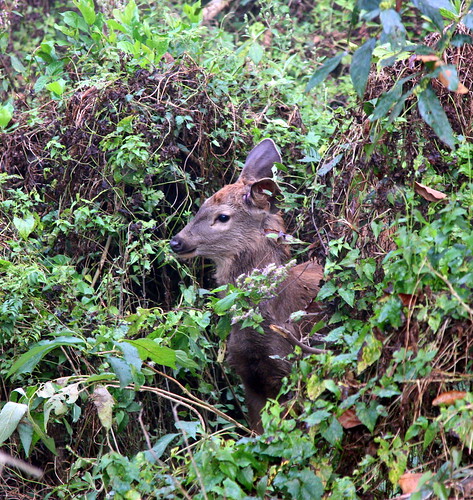

The ivy-like vine surrounding the deer is (according to our elephant handler, or mahout) an invasive South American weed, furiously overrunning the forest. It has apparently consumed more than a tenth of the very large park, and is resistant to all reasonable methods of extermination short of napalm.
From a wildlife perspective, it was an underwhelming journey. It was, however, crowded with exotic birds, the occasional camera-shy warthog, and and beautiful scenery.I did see a few elephants (namely the ones carrying us):
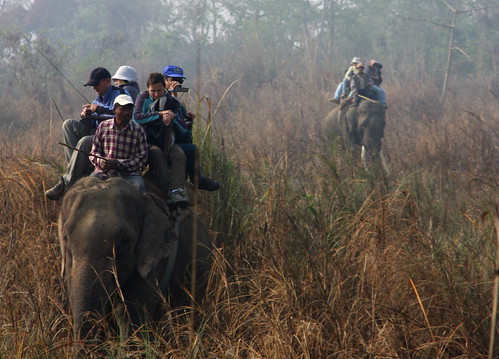
Better was to come later in the day. My uncooperative internet connection, I regret to say, is stubbornly refusing to upload the remainder of the day's photos, so it appears that finer photos will be yours tomorrow. More to come!
Tuesday, April 21, 2009
Because it would never have occurred to me to play ping pong with a temple step as the playing surface, a row of bricks as the net, and books taped to sticks as the paddles. Necessity is truly the mother of invention:
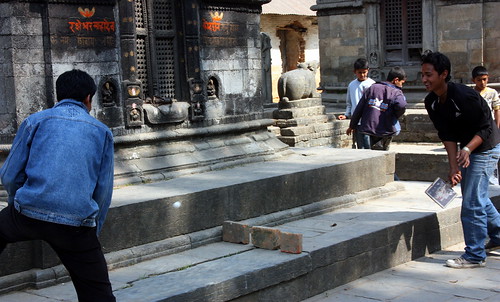
This is from Pashupatinath temple, the holiest Hindu site in Nepal, and apparently something of a recreational hotspot as well.
Sunday, April 19, 2009
For today, anyways: not only is it intolerably cute, but also it contains somewhere the germ of an incredibly interesting study in information ecology and non-reciprocal altruism. Fun!
Or, at least, closer to it than I've ever been before.
Life trundles along apace in Kathmandu. Work is a harmless drudgery of proposal research and proposal writing, punctuated by flurries of deadline-motivated hyperactivity and the occasional spasm of frustration, all of which are entirely par for the course in the part of the world (i.e. the poor part). I'm tolerably content with my work; dream job it ain't, but it's worlds better than being stuck behind a desk wondering whether I'd ever get back out into the great wide world.
So, short of enlightening revelations about my job, I offer instead more photos from the high Himalayas!
A couple of hours North (and up!) from the waystation of Namche Bazaar is the minute Sherpa village of Khunde, a hive of nestled in a shallow valley in the shadow of Khumbila, a snowless peak mildly sacred to local Buddhists (among whom the Sherpas are entirely included) and thus forbidden to climbers. Khunde is a resilient community of surprisingly precise and sturdy stone houses, intermingled with scattered patches of unwatered gravel that the locals somehow coax into producing vegetables. From the village itself, there's little to see, aside from the local Stupa and Khumbila itself which, in a landscape positively crowded with its more towering sisters, isn't much to look at.
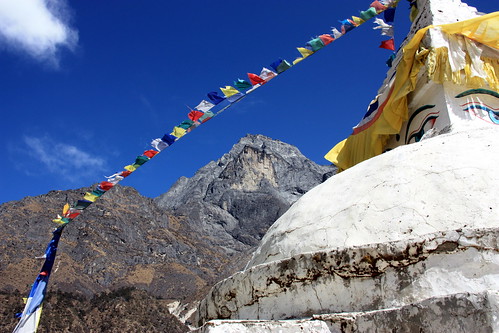
There's a hidden gem above Khunde, however, unknown even to our Sherpa Mingma and most of the villagers, and which we found solely through the assistance of a hand-drawn map provided by my trailblazing Canadian friend Craig. About 400 meters above Khunde, on a unnerving knife-edged ridge overlooking every village and valley in the region, are three memorials erected in the memory of Sir Edmund Hillary, first summitteer of Mt. Everest (along with Sherpa Tenzing Norgay), and his wife and daughter, who sadly predeceased him in a plane crash. Hillary is "our God" in the words of Mingma, and is widely revered for spending much of his post-Everest life bringing schools, medical services, and other vital social improvements (many of which bear his name) to the unspeakably remote Solukhumbu region that hosts the Everest mountain range. After his death in 2007, local Buddhist monks in the Khumbu built these traditional stone memorials in a location whose startling inaccessibility and even more impressive view fit the legend of the man. Forest fire smoke wreathed the valleys below, but the view lost none of its power.
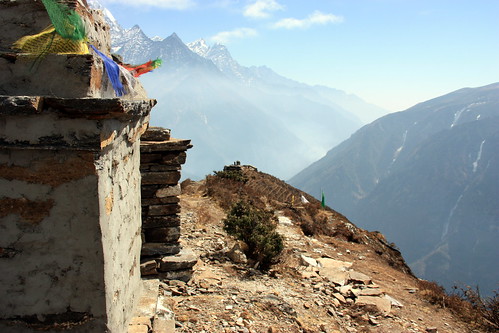
From the memorials, there's an astonishing view of the Everest range, perhaps the best you'll find without making the two week trek to Base Camp and Kalapattar.
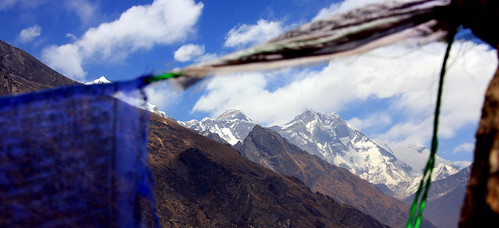
The distant black pyramid at the photo's center is Everest, which must be seen to be believed, and which is sacred to all the peoples of the region and has acquired more names than I can recount. For the record, here's the closest view I had of Sagarmatha, Chomolungma Goddess Mother of the World:
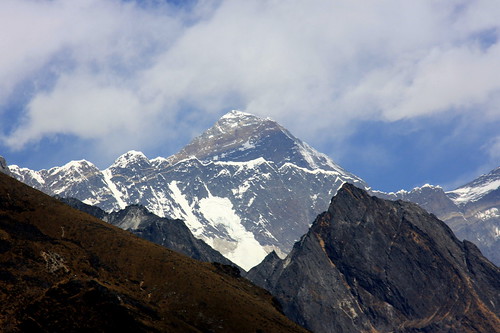
By Mingma's estimate, we reached 4500 metres, a kilometre up from Namche and a hair over halfway to Everest's peak. Not surprisingly, that's the highest I've ever travelled. Ye gods, what a walk it was.
More photos and tales will come, in characteristically discontinuous and scattershot fashion. With Nepali power and internet connections, this is a slow process, but I've much to show of the rest of the trek, an elephant ride, and last month's rather different sojourn to Hong Kong.
Friday, April 17, 2009
Behnaz, who has been communicating telepathically with my blog (again) over my explicit objections, tells me that it misses me (and despises purple). I too, despise purple, and in recognition of this commonality (and the very gradually improving electrical situation in Kathmandu) have found the opportunity (though barely the bandwidth) for some photoblogging of a portion of the 2000+ photos I've taken in the last few months. I even managed to upload 4 photos from my recent trip into the Himalayas, a feat that only required 4 hours (the uploading, not the trip). You will be sick of mountain photos by the time I'm truly done, and you'd best make your peace with that now.
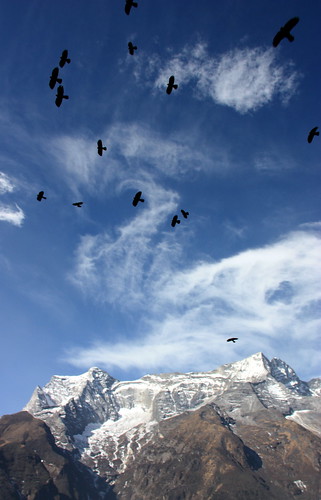
These birds, whose names I do not know, chased thermals in the valley between Namche Bazaar, a key trekkers waystation en route to the Himalayan peaks, and Kongde, an astonishing 6,187 metre peak that looms over much of the lower Himalayas. Shorter by nearly 3 kilometres than Everest, Kongde Ri is nonetheless indescribably beautiful in person - the impact of seeing such a mountain for the first time is something that I, rarely at a loss for words, am still seeking to vocabulary to convey. You'll probably have to come see it for yourselves.
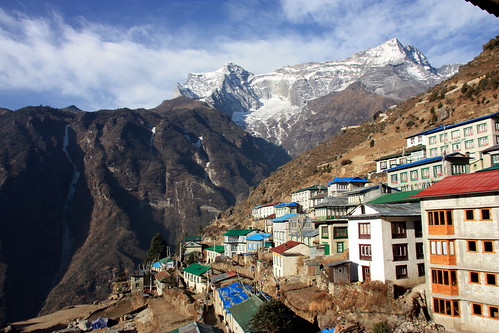
Tuesday, April 14, 2009
It's 2066 by the Nepali Hindu calendar! My bottom-floor neighbours rang in the New Year by getting furiously drunk, hurling bricks at each other, and apparently breaking a bottle over our guard's head. Bloody hell. He's all bandaged up now (no thanks to the bludgeoner) and I'm very cranky at the stupidity of it all.
No news as yet on my Foreign Service application - which is, I'm told, good news. I should have a more definitive answer by the end of the month.
Saturday, March 21, 2009
It's raining. That's fantastic.
Mind you, it's not coming down hard, and the sky is giving us fitful volleys of hail along with the rain. But I'm optimistic that it will disperse a bit of the suffocating ABC (Asian Brown Cloud) that's currently choking Nepal, along with most of South Asia. The ABC is a kilometres-thick layer of haze and soot, an unhappy consequence of unregulated vehicles and power plants, burning agricultural waste and literally billions of cookfires fueled by wood or cow dung. It reduces sunlight so much that it's been markedly colder here the last couple of weeks, obscures anything a kilometre away and, incidentally, kills millions of people each year. It's both fascinating and horrifying, and I'm eager for the end of it, which will only really come with the start of full monsoon rains in May or June. Today's short shower is only that, and sadly it's already over. Damn.
In other news, the Nepalese Free Student Union, a student government pervasively aligned with the uncountable, incomprehensible political parties, held its elections this week. Since most of the affected campuses were between me and my office, I skipped work for the day and took photos instead. This being Nepal, it's inconceivable that such an event wouldn't cripple traffic across the entire city. The elections blocked Durbar Marg, the main North-South street in central Kathmandu, for the entire day. Traffic would have a rough time getting through this:

The enthusiasm was remarkable, and occasionally unsettling, given the alignment of the various student parties with larger political groups who cheerfully demonstrate their capacity for violence whenever given the opportunity. There was even a super-fan, with his support painted across his body, leading a marching rally:
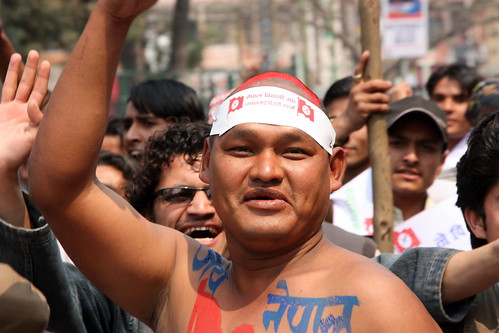
Police, either fearing violence or eager for it, kept a careful eye on the whole thing:
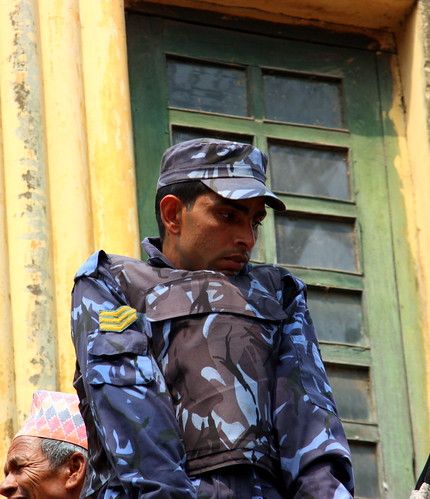
Oh, and Nepalese students are still rather like ours, give or take a few years, in some fairly universal ways:
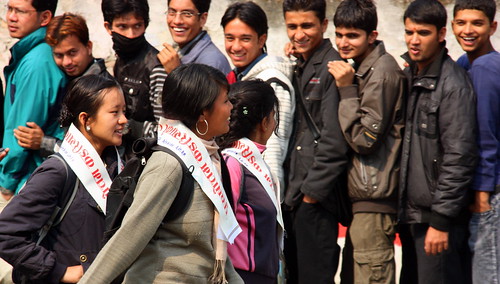
But there's no denying the marked fervour of the whole process, relative to the much-ignored (but nearly as corrupt) process of student politics in Canada.
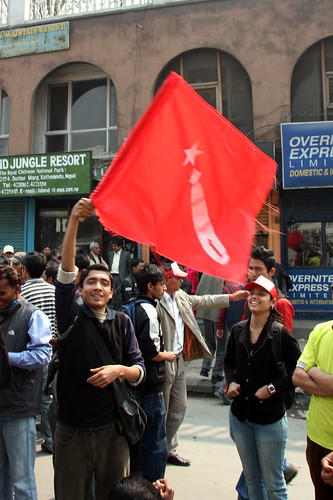
I spent a few hours there, curious as to whether the zeal would turn to aggression and the relative order to a maelstrom. Most students cheerfully obliged my intrusions with my camera and, satisfied that things might actually remained peaceful, I took off.
Later in the day, riots at polling stations in East Nepal (and the heavy-handed police response) killed one student and injured hundreds, some of whom are not expected to survive their wounds. Pipe bombs went off at university poll about 90 kilometres from here, wounding six students. This is Nepal, after all - can't have things being settled by a free and peaceful election, can we?
I neither know nor care who won the election.
Wednesday, March 18, 2009
What a change...
It's been a complex week, for a number of reasons. One of the biggies is that it's quite a transition to move from
Over the last two weeks, much of southern
This is the brutal logic of
With the exception of
Wednesday, March 11, 2009
Life may begin to calm down a bit after this week. I've just concluded the toughest and most important interview of my life (thus far). I'm tolerably confident I succeeded, but it'll be up to two months before I truly know.
Meanwhile, I LOVE Hong Kong! Though it's ridiculously consumeristic and not the least bit friendly, it's kinetic, clean, effective, and full of fascinating sounds and alluring smells. It has reliable electricity, drinkable water, traffic lights (that are consistently obeyed) and enticing food left and right. Most compellingly, not once in the last two days have I felt the need to scream "Why #@$^%$@# bloody @#$@#% doesn't this work the way it's supposed to!!!"
Methinks Kathmandu has lowered the bar for what amazes me. It will be a hard adjustment going back, which I'll be doing in a few minutes.
Pictures to follow, if the electricity ever comes back on again in Nepal.
Argh.
Monday, February 16, 2009
Definitely going to Hong Kong, on March 8th... now I'm just waiting for DFAIT to send me the vital details so I don't show up hideously unprepared.
Power still goes out 16 hours a day, but may improve by the beginning of March.
And I'm going to make a concerted effort to resurrect the blog despite the energy crisis in Nepal.
Sunday, February 01, 2009
Thursday, January 22, 2009
Zimbabwe's inflation rate is now believed to exceed 13 quadrillion percent per month, which works out annually to the absolutely fantastic number of 2.3 * 10^193. Now since that number isn't nearly as fun in scientific notation, let's also think of it as:
- 2,329,800,000,000,000,000,000,000,000,000,000,000,000,000,000, 000,000,000,000,000,000,000,000,000,000,000,000,000,000,000, 000,000,000,000,000,000,000,000,000,000,000,000,000,000,000, 000,000,000,000,000,000,000,000,000,000,000,000,000,000,000, 000,000,000,000,000.
- Two thousand three hundred and thirty vigintillion vigintillion vigintillion.
- More than the number of elementary particles in the entire universe.
Isn't it amazing what going absolutely bonkers with a banknote printing press will accomplish?
Tuesday, January 20, 2009
Monday, January 19, 2009
During which the full force of the energy crisis hit me, crippling my ability to blog. But in brief...
I published my first book, of which I am the editor and uncredited co-author: "Reporting Safe Migration and Human Trafficking: A Guide for Media Practitioners". The bloodless title was not my idea.
I was named the Best-Dressed Person working for CECI (my employer) in Nepal. That's a little like being the tallest midget at the circus, but hey, it's better than a poke in the eye with a sharp stick.
I've got a job interview with the Canadian Foreign Service! I'll be off to (probably) Hong Kong in (probably) early March. Joy!
I'm trying to come up with something profound and insightful to say about Obama's epic inauguration tomorrow, but so far I've been lethargic with an incredible swell of relief that the catastrophic reign of Bush is finally at its end. I'll think hard about what to say by tomorrow.
Monday, January 12, 2009
When the Buffalo Beast's delectable new edition of the 50 Most Loathsome People in America is released onto unsuspecting web audiences. If you can tolerate bitter satire laced with a total lack of regard for human decency, this one's for you. Just try to get past the Obama listing if you're fragile.
Sunday, January 11, 2009
This is a complex place.
We have 4 hours of useful electricity per day.
There are occasional street riots, though I've been unable to find them each that they've happened.
Cows graze on garbage here, rather than grass, which contradicts everything I thought I knew about ruminant gastroenterology.
And there are rumours of an imminent military coup swirling about. I don't think it would be like the one in Thailand.
For such a small, poor country, Nepal has phenomenally Byzantine politics. This blog will, for the foreseeable future, focus on decoding this insanity, until my employers or more sinister forces tell me to stop.
Friday, January 09, 2009
Which merely emphasizes the urgency of what I'm about to say: Slumdog Millionaire is absolutely fantastic. If you haven't already seen it (and if you're in a comfortable Western country, shame on you) cancel all other plans, skip work, and go see it right now. It has quickly elbowed its way into my all-time Top Ten, and may even have dethroned The Dark Knight as my favourite movie of the year.
OK, now I'm going to bed.
Sunday, January 04, 2009
Thursday, January 01, 2009
Happy New Year from Kathmandu! Hopefully yours was eventful and brought little agony the next morning. Last night I reveled in the one-day suspension of Kathmandu's draconian 11PM curfew, and with a handful of other impoverished Canucks wandered from bar to restaurant to bar to scuzzy sandwich joint to bar to mysterious tower block in the midst of this odd urban wasteland. I rediscovered my genuine affection for Bhangra music, and surreptitiously dumped mystery shots (pure vodka, I think) into the fountain of one of Kathmandu's classiest restaurants. I got home at 5AM, and for some unrelated reason I'm a mite foggy today...
...
...
